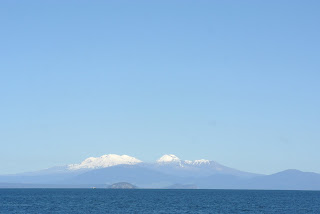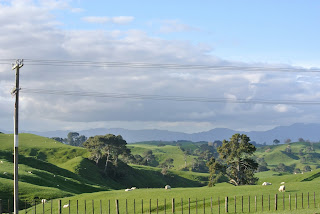On a hot sunny day - hotter and sunnier than it ever was on the North Island - we go for a 'tramp' along the coast track of New Zealand's smallest National Park, Abel Tasman. Like many places in New Zealand it is named after an explorer. This one was Dutch and didn't stay for long after four of his men died in a 'skirmish' with the local Maori inhabitants, but he still got one of the most beautiful parks in the county named after him - I'm sure he did some more sucessful exploring too.
There are no roads into the park and only a few privately owned and very expensive holiday homes, so we drive to Kaiteriteri the town on the edge of the resort to book a water taxi. One local described Kaiteroteri to us as 'busy and over-built'. Its about the size of a Cornish fishing village - small one. The water taxi drops us at Tonga, a couple of bays up the coast, having stopped to look at Split Apple Rock and a few seals, sun bathing on the rocky islands just off the coast.
From Tonga we walk along the coast path, much of which is through the bush with only occasional sightings of the ocean, but when I do catch a glimpse its worth the wait. Sightings are through pine trees and of greeny-blue water fringed by golden sand, making me think of Greece of Croatia. The sun is hot and the breeze is cool.
At 7ne point we take a short cut, wading through Bark Bay estuary while the tide is still low enough to leave vast islands of white sand. The short cut turns into a detour as we frolic on the sand, taking photos, doing hand-stands and swimming. We stay until we're left on a tiny spit then wade across to the tramper's hut on far beach. We now only have a few hours to get to the beach where the boat is picking us up, so we don't have much time to dawdle. We consider another short cut across a much bigher estuary further along the coast, cutting our walking time by an hour, but by now the tide is completely in and we would be swimming.
We make it to Anchorage Bay with thirty minutes to spare. Its very hot and I'm looking forward to some sun bathing and maybe a swim. However when I stop walking the wind cools me down considerably and I'm even cold. On the boat I put my rain coat on against the spray as I watch the beautiful coast line turn into 'over-built' Kaiteriteri. I had orginally been planning to get an icecream at the town's only shop (thats how big it is) but now the sun has gone down and the glow from walking has left me I get another pie.
There are no roads into the park and only a few privately owned and very expensive holiday homes, so we drive to Kaiteriteri the town on the edge of the resort to book a water taxi. One local described Kaiteroteri to us as 'busy and over-built'. Its about the size of a Cornish fishing village - small one. The water taxi drops us at Tonga, a couple of bays up the coast, having stopped to look at Split Apple Rock and a few seals, sun bathing on the rocky islands just off the coast.
From Tonga we walk along the coast path, much of which is through the bush with only occasional sightings of the ocean, but when I do catch a glimpse its worth the wait. Sightings are through pine trees and of greeny-blue water fringed by golden sand, making me think of Greece of Croatia. The sun is hot and the breeze is cool.
At 7ne point we take a short cut, wading through Bark Bay estuary while the tide is still low enough to leave vast islands of white sand. The short cut turns into a detour as we frolic on the sand, taking photos, doing hand-stands and swimming. We stay until we're left on a tiny spit then wade across to the tramper's hut on far beach. We now only have a few hours to get to the beach where the boat is picking us up, so we don't have much time to dawdle. We consider another short cut across a much bigher estuary further along the coast, cutting our walking time by an hour, but by now the tide is completely in and we would be swimming.
We make it to Anchorage Bay with thirty minutes to spare. Its very hot and I'm looking forward to some sun bathing and maybe a swim. However when I stop walking the wind cools me down considerably and I'm even cold. On the boat I put my rain coat on against the spray as I watch the beautiful coast line turn into 'over-built' Kaiteriteri. I had orginally been planning to get an icecream at the town's only shop (thats how big it is) but now the sun has gone down and the glow from walking has left me I get another pie.


















